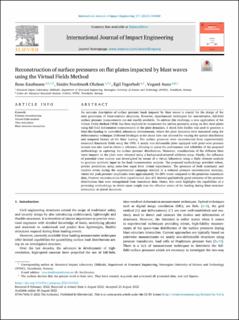| dc.contributor.author | Kaufmann, Rene | |
| dc.contributor.author | Olufsen, Sindre Nordmark | |
| dc.contributor.author | Fagerholt, Egil | |
| dc.contributor.author | Aune, Vegard | |
| dc.date.accessioned | 2022-11-30T09:57:25Z | |
| dc.date.available | 2022-11-30T09:57:25Z | |
| dc.date.created | 2022-09-01T20:21:32Z | |
| dc.date.issued | 2023 | |
| dc.identifier.issn | 0734-743X | |
| dc.identifier.uri | https://hdl.handle.net/11250/3034960 | |
| dc.description.abstract | An accurate description of surface pressure loads imposed by blast waves is crucial for the design of the next generation of blast-resistant structures. However, experimental techniques for non-intrusive, full-field surface pressure measurements are not readily available. To address this challenge, a new application of the Virtual Fields Method (VFM) has been explored to reconstruct the surface pressures acting on thin steel plates using full-field deformation measurements of the plate dynamics. A shock tube facility was used to generate a blast-like loading in controlled, laboratory environments, where the plate dynamics were measured using the deflectometry technique. Different blockages at the shock tube exit allowed for varying the spatial distribution and temporal history of the blast loading. The surface pressures were reconstructed from experimentally measured kinematic fields using the VFM. A nearly non-deformable plate equipped with point-wise pressure sensors was also used to obtain a reference, allowing to assess the performance and reliability of the proposed methodology in capturing the surface pressure distributions. Moreover, visualizations of the different blast wave impacts on the plate were obtained using a background-oriented schlieren setup. Finally, the influence of potential error sources was investigated by means of a virtual laboratory using a finite element analysis to generate synthetic input to the load reconstruction analysis. The proposed methodology provided robust, precise predictions using noise-free input from virtual experiments. The presence of both systematic and random errors during the experimental campaign resulted in a reduced pressure reconstruction accuracy, where the peak pressure amplitudes were approximately 10–20% lower compared to the pointwise transducer data. Pressure reconstructions from experimental data still showed qualitatively good estimates of the pressure distributions that were extrapolated from transducer data. Hence, this work highlights the capabilities of a promising methodology to obtain more insight into the effective action of the loading during blast–structure interaction of plated structures.
Previous article in issue | en_US |
| dc.language.iso | eng | en_US |
| dc.publisher | Elsevier Science | en_US |
| dc.relation.uri | https://www.sciencedirect.com/science/article/pii/S0734743X2200210X | |
| dc.rights | Navngivelse 4.0 Internasjonal | * |
| dc.rights.uri | http://creativecommons.org/licenses/by/4.0/deed.no | * |
| dc.title | Reconstruction of surface pressures on flat plates impacted by blast waves using the Virtual Fields Method | en_US |
| dc.title.alternative | Reconstruction of surface pressures on flat plates impacted by blast waves using the Virtual Fields Method | en_US |
| dc.type | Peer reviewed | en_US |
| dc.type | Journal article | en_US |
| dc.description.version | publishedVersion | en_US |
| dc.source.volume | 171 | en_US |
| dc.source.journal | International Journal of Impact Engineering | en_US |
| dc.identifier.doi | 10.1016/j.ijimpeng.2022.104369 | |
| dc.identifier.cristin | 2048091 | |
| dc.relation.project | Norges forskningsråd: 294748 | en_US |
| dc.relation.project | Norges forskningsråd: 237885 | en_US |
| cristin.ispublished | true | |
| cristin.fulltext | original | |
| cristin.qualitycode | 2 | |

